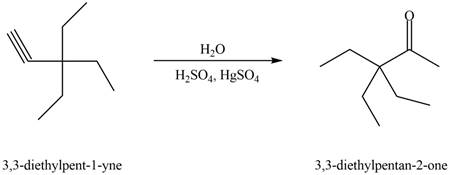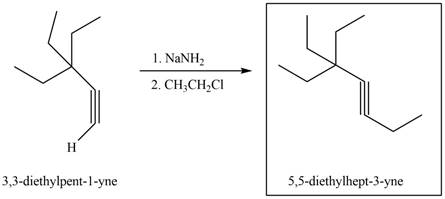
Concept explainers
What reagents are needed to convert
a.  b.
b.  c
c d.
d. 
(a)
Interpretation: The reagents that are needed to convert
Concept introduction: A terminal alkyne reacts with
Answer to Problem 11.34P
The reagents that are needed to convert
Explanation of Solution
The reagents that are needed to convert

Figure 1
The terminal alkyne,
The reagents that are needed to convert
(b)
Interpretation: The reagents that are needed to convert
Concept introduction: A stepwise procedure of transforming an alkyne into a carbonyl group is known hydroboration-oxidation reaction. In a hydroboration-oxidation reaction, a terminal alkyne reacts with
Answer to Problem 11.34P
The reagents that are needed to convert
Explanation of Solution
The reagents that are needed to convert

Figure 2
The terminal alkyne,
The reagents that are needed to convert
(c)
Interpretation: The reagents that are needed to convert
Concept introduction: The ellectrophillic reaction which involves the reaction of an alkene or alkyne with
Answer to Problem 11.34P
The reagent that is needed to convert
Explanation of Solution
The reagents that are needed to convert

Figure 3
The terminal alkyne,
The reagent that is needed to convert
(d)
Interpretation: The reagents that are needed to convert
Concept introduction: The replacement or substitution of one functional group with another different functional group in any chemical reaction is termed as substitution reaction. The nucleophilic reaction that consists of bimolecular as well as bond-making and bond-breaking steps is termed as
Answer to Problem 11.34P
The reagents that are needed to convert
Explanation of Solution
The reagents that are needed to convert

Figure 4
The terminal alkyne,
The reagents that are needed to convert
Want to see more full solutions like this?
Chapter 11 Solutions
Organic Chemistry
Additional Science Textbook Solutions
Introduction to Chemistry
Chemistry: Atoms First
Introductory Chemistry (6th Edition)
Chemistry: A Molecular Approach
General, Organic, and Biological Chemistry (3rd Edition)
- 10.64 Devise a synthesis of each compound from cyclohexene as the starting material. More than one step is needed. a. CO b. C. CN OH "SH + enantiomerarrow_forwardGive the IUPAC name for each compound. CH3 a. CH,CHCH-C CHO b. CH3 H CH2CH3arrow_forwardSynthesize each compound from acetylene. You may use any other organic or inorganic reagents. C. CH,CH,CH,CH, CHO d. CH3CH, CHỖ CHarrow_forward
- 1. Classify each substituent as electron donating or electron withdrawing LOCH3 C(CH3)3 OCOCH3 b. CN a. b. a. C.arrow_forwardDraw the products formed when (CH3)2C=CH2 is treated with each reagent. a.HBr b. H2O, H2SO4 c. CH3CH2OH, H2SO4 d. Cl2 e.Br2, H2O f.NBS (aqueous DMSO) g.[1] BH3; [2] H2O2, HO−arrow_forwardSynthesize each compound from cyclohexanol using any other organic or inorganic compounds. CH,OH a. g. (Each cyclohexane ring must come from cyclohexanol.) COOH b. d. h. сно CHs (Each cyclohexane ring must come from cyclohexanol.)arrow_forward
- Give the IUPAC name for each compound. a. H-C=C-CHC(CH,CH;CH3)3 b. CH3C= CC(CH3)CICH,CH3 c. CH2= CHCH;CH(CH,CH;)C = CC(CH)CH2CH;CH3arrow_forward10.38 Give the IUPAC name for each compound. а. b. С. d. ОН е. f.arrow_forward11.34 What reagents are needed to convert (CH3CH2)3CC=CH to each compound? a. b. CICI H C. d.arrow_forward
- I. Give the IUPAC name for each compound: a. (CH3),C=CHCH,CHCH,CH3 ČH,CH,CH3 b. (CH3)3CC=CC(CH3)3 c. (CH;CH,CH,CH2)2C=CHCH3arrow_forwardLabel each pair of alkenes as constitutional isomers, stereoisomers, or identical. А. and constitutional B. and isomers identical stereoisomers C. CH3 and H. constitutional isomers CH3 CH3 CH3CH2 CH2CH3 CH3CH2 CH3 D. and CH3 CH3 CH3 CH2CH3 I-arrow_forwardDraw the products of each reaction, including stereochemistry. Br2 a. b.arrow_forward
 ChemistryChemistryISBN:9781305957404Author:Steven S. Zumdahl, Susan A. Zumdahl, Donald J. DeCostePublisher:Cengage Learning
ChemistryChemistryISBN:9781305957404Author:Steven S. Zumdahl, Susan A. Zumdahl, Donald J. DeCostePublisher:Cengage Learning ChemistryChemistryISBN:9781259911156Author:Raymond Chang Dr., Jason Overby ProfessorPublisher:McGraw-Hill Education
ChemistryChemistryISBN:9781259911156Author:Raymond Chang Dr., Jason Overby ProfessorPublisher:McGraw-Hill Education Principles of Instrumental AnalysisChemistryISBN:9781305577213Author:Douglas A. Skoog, F. James Holler, Stanley R. CrouchPublisher:Cengage Learning
Principles of Instrumental AnalysisChemistryISBN:9781305577213Author:Douglas A. Skoog, F. James Holler, Stanley R. CrouchPublisher:Cengage Learning Organic ChemistryChemistryISBN:9780078021558Author:Janice Gorzynski Smith Dr.Publisher:McGraw-Hill Education
Organic ChemistryChemistryISBN:9780078021558Author:Janice Gorzynski Smith Dr.Publisher:McGraw-Hill Education Chemistry: Principles and ReactionsChemistryISBN:9781305079373Author:William L. Masterton, Cecile N. HurleyPublisher:Cengage Learning
Chemistry: Principles and ReactionsChemistryISBN:9781305079373Author:William L. Masterton, Cecile N. HurleyPublisher:Cengage Learning Elementary Principles of Chemical Processes, Bind...ChemistryISBN:9781118431221Author:Richard M. Felder, Ronald W. Rousseau, Lisa G. BullardPublisher:WILEY
Elementary Principles of Chemical Processes, Bind...ChemistryISBN:9781118431221Author:Richard M. Felder, Ronald W. Rousseau, Lisa G. BullardPublisher:WILEY





